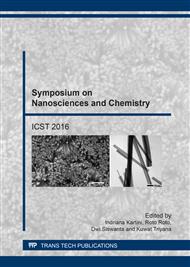[1]
M.J. Lerma-Garcia, J.M. Herrero-Martinez, E.F. Simo-Alfonso, C.R.B. Mendonca, G. Ramis-Ramos, Composition, industrial processing and applications of rice bran–oryzanol, Food Chemistry 115 (2009) 389–404.
DOI: 10.1016/j.foodchem.2009.01.063
Google Scholar
[2]
B.J. Lloyd, T.J. Siebenmorgen, and K.W. Beers, Effects of commercial processing on antioxidants in rice bran, Cereal Chem. 77 (2000) 551–555.
DOI: 10.1094/cchem.2000.77.5.551
Google Scholar
[3]
M. Patel and S. N Naik, gamma-Oryzanol from rice bran oil-a review, Journal of Scientific & Industrial Research 63 (2004) 569-578.
Google Scholar
[4]
M.H. Chen and C.J. Bergman, A rapid procedure for analyzing rice bran tocopherol, tocotrienol and g-oryzanol contents, Journal of Food Composition and Analysis 18 (2005) 139-151.
DOI: 10.1016/j.jfca.2003.09.004
Google Scholar
[5]
W. Stoggl, C. Huck, S. Wongyai, H. Scherz, and G. Bonn, Simultaneous determination of carotenoids, tocopherols, and g-oryzanol in crude RBO by liquid chromatography coupled to diode array and mass spectrometric detection employing silica C30 stationary phases, Journal of Separation Science 28 (2005).
DOI: 10.1002/jssc.200500176
Google Scholar
[6]
R.R. Devi and C. Arumughan, Phytochemical characterization of defatted rice bran and optimization of a process for their extraction and enrichment, Bio resource Technology 98 (2007) 3037-3043.
DOI: 10.1016/j.biortech.2006.10.009
Google Scholar
[7]
A.V. Narayan, R.S. Barhate, K.S.M.S. Raghavarao, Extraction and purification of oryzanol from RBO and RBO soapstock, Journal of the American Oil Chemists Society 83 (2006) 663–670.
DOI: 10.1007/s11746-006-5021-2
Google Scholar
[8]
X. Zhang, Y. Shen, W. Prinyawiwatkul, J.M. King, Z. Xu, Comparison of the activities of hydrophilic anthocyanins and lipophilic tocols in black rice bran against lipid oxidation, Food Chemistry 141: 1 (2013) 111–116.
DOI: 10.1016/j.foodchem.2013.03.034
Google Scholar
[9]
M.A. Da Silva, C. Sanches, and E.R. Amante, Prevention of hydrolytic rancidity in rice bran, Journal of Food Engineering 75 (2006) 487–491.
DOI: 10.1016/j.jfoodeng.2005.03.066
Google Scholar
[10]
L. Danielski, C. Zetzl, H. Hense, and G. Brunner, A process line for the production of raffinated rice oil from rice bran, Journal of Supercritical Fluids 34 (2005) 133–141.
DOI: 10.1016/j.supflu.2004.11.006
Google Scholar
[11]
G.H. Hu, S.H. Huang, S.W. Cao, Z.Z. Ma, Effect of enrichment with hemicellulose from rice bran on chemical and functional properties of bread, Food Chemistry 115 (2009) 839–842.
DOI: 10.1016/j.foodchem.2008.12.092
Google Scholar
[12]
M. Friedman, Rice brans, rice bran oils, and rice hulls: composition, food and industrial uses, and bioactivities in humans, animals and cells, Journal of Agricultural & Food Chemistry 61 (2013) 10626–10641.
DOI: 10.1021/jf403635v
Google Scholar
[13]
K. Gul, B. Yousuf, A.K. Singh, P. Singh, A.A. Wani, Rice bran: nutritional values and its emerging potential for development of functional food – a review, Bioactive Carbohydrates and Dietary Fibre 6 (2015) 24–30.
DOI: 10.1016/j.bcdf.2015.06.002
Google Scholar
[14]
P. Lai, K.Y. Li, S. Lu, and H.H. Chen, Analytical method: phytochemicals and antioxidant properties of solvent extracts from japonica rice bran, Food Chemistry 117 (2009) 538-544.
DOI: 10.1016/j.foodchem.2009.04.031
Google Scholar
[15]
D.D. Do, Adsorption Analysis: Equilibria and Kinetics, Imperial College Press, London, (1998).
Google Scholar
[16]
R.T. Yang, Adsorbents: Fundamentals and Applications, John Wiley & Sons, Inc., Hoboken, New Jersey, (2003).
Google Scholar
[17]
J.D. Seader, E.J. Henley, and D.K. Roper, Separation Process Principles: Chemical and Biochemical Operations, John Wiley & Sons, Inc., 3rd ed., (2011).
Google Scholar
[18]
M. Suzuki, Adsorption Engineering, Kodansha Ltd., Tokyo and Elsevier Science publishers B.V., Amsterdam, (1990).
Google Scholar
[19]
R.H. Perry and D.W. Green, and J.O. Maloney, Perry's Chemical Engineer's Handbook, The Mc-Graw Hill Companies, Inc., 7th ed., (1997).
Google Scholar
[20]
I. Tosun, Modelling in Transport Phenomena: a Conceptual Approach, Elsevier Science B.V., Amsterdam, (2002).
Google Scholar


